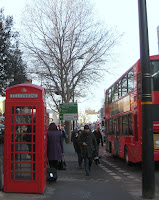The Grand Parade in the Place Royale, April 1612, Musee Carnavelet, Paris, Anonymous.
Butter, cream, foie gras, pastry, cheese - it's hard to say no to all those things in France since food is one of the country's great treasures. So, exercise it is. There are tons of gyms in Paris, but who wants to labor on a treadmill, when the whole beautiful city is just a walk away.
A few days ago, on a rare sunny winter day, I decided that the nearby Place des Vosges was perfect for a brisk morning walk. Originally called La Place Royale, it is one of the oldest and most beautiful squares in Paris. It was built between 1605 and 1612 by the king, Henry IV. It was Henry himself who imposed by royal edict the elegant symmetry of the 36 pavilions and four arcades that surround the square. All of them are of the same material, style and height - except, of course, for the Pavilion of the King and the Pavilion of the Queen, which are taller and more ornate.
The square itself is 127 by 140 meters, big enough for the king to stage huge ceremonies and festivals. In an hour, I can walk 12 times around the square, which adds up to four miles - and a whole lot of history.
Long before the elegant Place des Vosges, the square was the site of La Maison Royale des Tournelles - a vast and beautiful house whose gardens were surrounded by a high wall adorned with a large number of small towers. For almost two hundred years, several kings and would-be-kings lived and died here ending with Henry II in 1559. His queen was Catherine de Medici and his mistress was Diane de Poitiers. Twenty years his senior, Diane was also the king's trusted advisor.
At the age of 40, Henry was killed, not in battle, but in a jousting tournament, in which he carried the colors of Diane de Poitiers instead of those of the queen. The perpetrator was the head of Henry's Scottish Guards, Gabriel Montgomery, who obviously didn't know that you should always let the king win. It took ten days for the king to die and during that time, he is reported to have called out repeatedly for Diane, but the Queen banned her from the King's chambers. After the king's death, Montgomery wisely left Paris; Diane was banished to her chateau on the Loire; and Catherine, horrified by the event, moved with her eight children to the Louvre Palace. Four years later, she ordered the entire beautiful Maison Royale torn down. So effective was the demolition that today absolutely nothing remains of this massive edifice.
This cleared the way, so to speak, for the construction by King Henry IV of the Place Royale, today's Place des Vosges. Henry also built the Grand Gallery of the Louvre and the Pont Neuf bridge. Along with his faithful right-hand man, the Duke of Sully, Henry began to put State finances in order; preserved forest land, built tree-lined roads; erected bridges; and promoted education. Sully, in fact, had a beautiful mansion next to the Place des Vosges.
Under the buildings of the square are arcades, and after six turns around the garden, I decided to walk there. The arcades are lined with art galleries, exclusive stores and cafes. In the southeast corner is the Maison de Victor Hugo, where the author once lived and where there is an interesting museum devoted to his life and work. In the southwest corner is a door that leads to the gardens and the mansion of the Hotel de Sully. The Duke, who in his later years was quite a dandy, built the opening so he could easily promenade on the fashionable Place Royale. Decked out in diamonds and the insignia of his former power, he strolled among the other dukes, counts and countesses, who, according to a history of the time, "amused themselves at his expense."
Sully fell from power when Henry IV was assassinated in 1610, two years before the inauguration of the Place Royale. Instead, Henry's son King Louis XIII presided over the spectacle in honor of his engagement to Anne of Austria. The king was only eight at the time, so the marriage was postponed until he was 14.
Over the next century, the Place Royale remained a fashionable address, a site for parades and tournaments and a perfect dueling spot. It then began a slow decline and during the French Revolution, its name was changed several times. It sported such catchy monikers as Artillery Park Square, Arms' Makers Square, and Indivisibility Square. It got its present name in 1800 in honor of the French region of the Vosges, the first département to promptly pay Napoleon's war taxes.
Since the restoration of the Marais district in the 1960s, (click here to read Travel Oyster's Paris Past) the Place des Vosges has returned to its former glory. It is one of the most sought after addresses in Paris and is home to the modern-day monarchs of industry, government and the arts - and my very own exercise track.
To see more photos, click here.
A bientôt,
Geraldine












